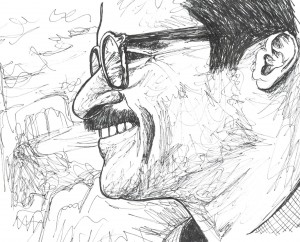To call “Her” a romance between a man and his operating system is to both trivialize the movie’s extraordinary depth and also get it exactly right. The latest picture from director Spike Jonze is so much more than its gimmicky premise might suggest, but it is also precisely this premise that becomes the wellspring for the film’s vast profundity. Even more than “Blade Runner” or “A.I” before it, “Her” explores the notion of humanity in the face of our ongoing technological revolution. It takes the topic of the singularity – the hypothetical point in time when artificial intelligence will have evolved beyond the intelligence of its human creators – and, deviating from the dystopian grandiosity seen in like-themed films like “Terminator 3” or “The Matrix”, scales the narrative down to the place where it matters: our everyday life and relationships, and how the advent of the singularity, not an absurd prospect considering the massive ground we’ve covered in artificial intelligence, could alter not only the social landscape but human nature itself.
For a filmmaker whose résumé includes opening a portal into John Malkovich’s head and concocting a meta-cinematic masterpiece starring not one but two Nicolas Cages, the concept of “Her” is really not that outrageous. Stylistically, the film is probably Jonze’s most palatable work yet, if not his least audacious. The entire production exudes a lovable whimsy that begins with its hero Theodore Twombly, played by a mustached and tender-hearted Joaquin Phoenix. Here is a man who writes love letters for a living, forging romantic messages for couples looking to communicate their feelings to one another. Using photos, journal entries and other memorabilia his customers send him, he extrapolates the nature of their relationships and composes letters accordingly. Theodore is very good at what he does, but the very idea of a letter writing service feels peculiar. What kind of society is this that demands third party mediation of its human relationships and replaces personal expressions of love with impersonal imitations of them?
As it turns out, this society is ours. The world of “Her” is set in the future, but just barely – it serves as a convincing projection of what things might look like in a couple of decades: sleek, ergonomic, and governed by screen technologies that render social interaction all but obsolete. Theodore’s job becomes not an isolated oddity but a metaphor for an entire way of life built around artificial mediation viz. the infiltration of technology into every aspect of our lives. “Her” captures a world caught up in an existential crisis, one that is unsure about what is real and what isn’t. The movie’s visual design reflects this by constantly blending the natural with the synthetic, the analog with the digital. Though set predominantly in the gorgeous urban sprawl of futuristic L.A., the movie takes sudden detours into naturalistic environments – a beach, for instance, or the stillness of a forest after snowfall. And even then, the film’s nature photography doesn’t feel completely organic – there’s a subtle sheen to the images that makes the colors feel slightly muted, creating an artificialized, though still beautiful, version of reality.
This tension between the real and unreal is epitomized by Samantha, Theodore’s love interest and an operating system programmed with intuition. Housed for all intents and purposes in Theodore’s phone (though she can really be many places simultaneously) and expressively voiced by Scarlett Johanssen, Samantha encapsulates the ultimate philosophical quandary of our age: if a machine can be programmed to feel, are its emotions real? They certainly sound real. Listening to Theodore and Samantha banter their way towards romance, one almost forgets that she is not simply another human character who just happens to be offscreen. Let down your guard and you’d think you were watching a movie about a long distance relationship between a guy and a girl, whom we can only hear over the phone.
But because we know that Samantha is fundamentally constructed even despite her seemingly authentic expressions of emotion, her characterization prompts us to look beyond emotion to the very hardwiring that goes into such feelings as sadness, anger, and love. Early in the film, we are informed that Samantha is capable of browsing millions of web pages in seconds and searching thousands of topics simultaneously. In less than a day, she can become an expert on psychology and human behavior. She can peruse books on social cues, memorize every idiomatic expression in the English language, and watch videos on performance art. Would it be possible, with all this information at her disposal, for her to emulate human emotion?
I’d say so. When Samantha composes two lovely pieces of music, we wonder where her artistic inspiration came from – some internal fount of creativity or a detailed study of history’s most lauded musical works? All this has major ramifications for humanist schools of thought. Are our emotions the innate measure of our humanity or merely the electrochemical result of firing neurons? Are they truly something special or simply a biological response to the data we gather from our surroundings? Data collection is essentially what Theodore’s job requires him to do: he researches his customers’ profiles and creates the semblance of emotion through his letters. In this respect, he and Samantha are quite similar – when they first meet each other, it’s no coincidence that his red shirt matches the color of the computer screen behind which her voice is first heard.
Assuming you take all this for granted and view Samantha as possessing valid emotions, there remains the issue of the romance itself, which invites discussion on whether the physical body is a prerequisite for a meaningful relationship. The concept of a sex scene between Theodore and Samantha sounds unbelievable until you witness it. The basic structure of the scene recalls an earlier instance of phone sex, during which Theodore fantasizes about a supermodel. In this first case, he knows there is someone physically at the other end of the phone, and so his fantasy is, in a way, legitimatized – the film accordingly grants us subjective shots of his lascivious reverie. But what does he envision when making love to an OS? Recall how I described Samantha as residing in Theodore’s phone even though she is technically elsewhere at the same time. As humans, our perceptual plane resides within the physical dimension – we feel the need to mentally link someone to a body in order to fully conceptualize them as a person. For her, the closest thing to a body would be the phone, and indeed, I often found myself treating it as if it were Samantha.
Sex complicates this already complicated ordeal. Unless Theodore is aroused by the object of the phone, sex with Samantha is a perplexing notion. Because sexual arousal is a phenomenon that entails a biological body, does physical stimulation require that he picture someone else’s body and respond to that? Could such a relationship ever be truly intimate? From Samantha’s point of view, things get even more enigmatic. Anatomically unable to experience sex (she is only gendered female because of her voice), Samantha’s expressions of pleasure seem necessarily artificial, and yet the earnestness of Johanssen’s performance, along with the film’s quiet acceptance of it all, suggests otherwise.
When the scene reaches its climax, the screen switches to black, and all we hear are the sounds of rapture. The soundtrack climbs and swells, lifting us up beside the lovers into a place of transcendence. The result is at once beautiful, confusing, and more than a little unsettling. Whether or not it’s possible, sexuality has somehow moved away from the realm of the physical into a space of pure feeling. In this moment, the movie teeters on the edge of human understanding, suggesting something greater than ourselves, a new and barely glimpsed frontier in mankind’s pursuit of knowledge. It’s one of two instances in “Her” that rival the luminous third act of “2001: A Space Odyssey,” and when the darkness falls away to reveal the L.A. nightscape, the culmination of this exultant scene, the experience is akin to the second coming of the star child.
The other instance occurs at the film’s conclusion, and it’s more mysterious still. Without giving away the plot, let’s just say that Samantha, though initially “human” with her built-in intuition, evolves at such an accelerated rate that she becomes less and less able to interact with flesh-and-blood humans as the film progresses. We are invited to question whether humanity is defined by its limitations, or whether it’s a constantly shifting ideal. The film provides no answers, for how could it? However talented a filmmaker Jonze may be, he is still human like the rest of us and therefore bound by the same restricted worldview. What ultimately makes “Her” so brilliant are not the resolutions it provides but its curiosity, the way it stares intently into the unknown and strains to see, if only for a moment, that which is unseen. The movie takes full stock of humanity in all its baffling contradictions, places it beneath the microscope then telescopes it upward to map out the stars. Watching the film is to have your every sense and sensibility stimulated by the thrill of a great question explored through the power of cinema. What is humanity? Who knows, but the journey to find the answer, especially if guided by Spike Jonze, is well worth taking.



